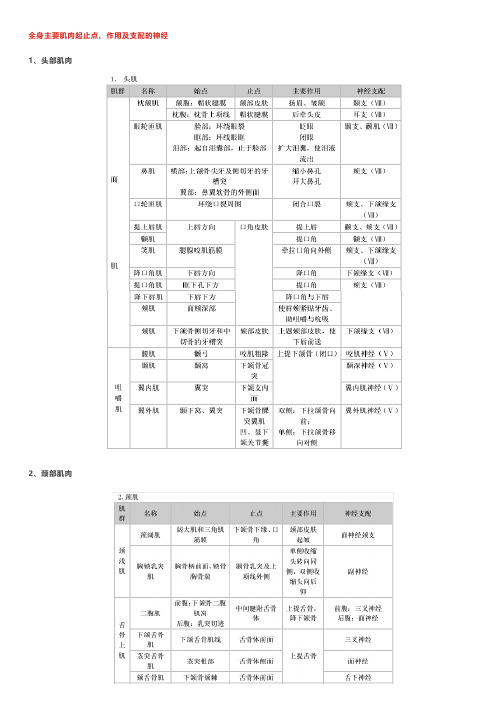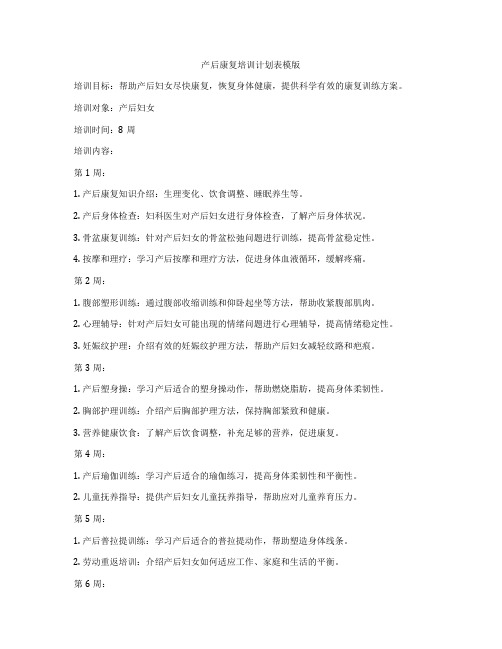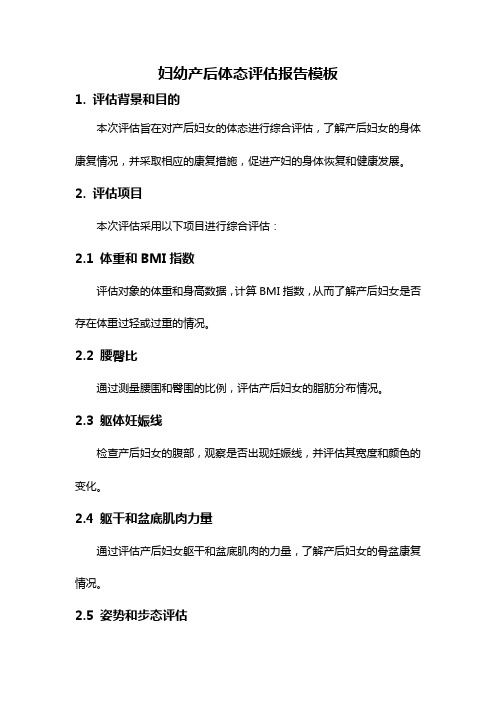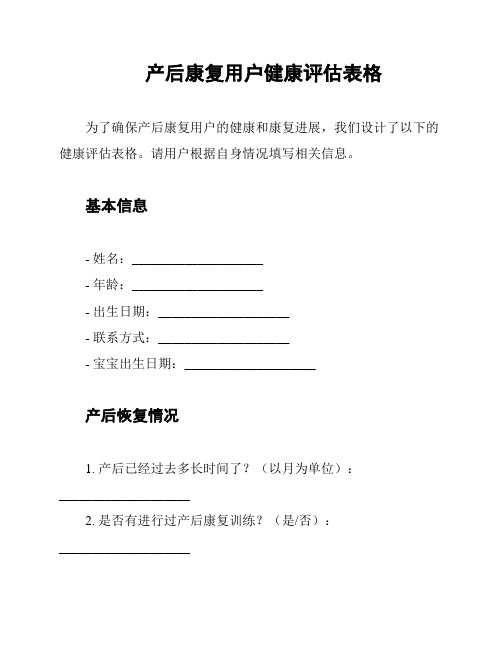简述产后康复评估的流程的表格
产后恢复表格大全

产后恢复表格大全晨会前准备工作晨会流程喜邦艾月儿产后修复中心晨会及当值排表产康师顾客档案表产康师月预约统计表产康师月份喜邦艾月儿产后修复产康师当天护理中推销、沟通情况表产康师月份喜邦艾月儿产后修复中心产康师月度考核评分表店月本月优秀产康师评选:姓名:加分:注:1.业绩考核身体需占总金额的30%(月完成业绩1.5万;奖金50元;2万100元;3万200元)2.预约分100个项目为10分,其中身体项目需占30%3.专业考核不低于70分4.综合评分四项(除业绩分)不低于35分以上不达标均取消综合评分奖喜邦艾月儿产后修复中心喜邦艾月儿产后修复中心每月责任扣分记录店年月注:1分扣5元。
重复原因扣分双倍罚款。
主管签名每日前台登记表产康师预约表年月日顾客预约表产康师正在服务状况表每月顾客流失状况表店月份卡完一周内回访一次,一个月两次,两个月之内三次,半年五次。
主管签名:一个月没有做护理回访记录店年月产康师注:每月电话跟踪不得低于3次,少于3次电话跟踪扣1分。
电话跟踪记录要详细,记录不清楚扣分1分。
主管签名:喜邦艾月儿产后修复中心顾客资料管理产后恢复顾客档案资料卡加盟院:年月日顾客签名:产康师签名:产后恢复顾客护理记录表加盟店:年月日产后恢复顾客护理记录表加盟店:年月日产康顾问:指定护理产康师:产后恢复老顾客名册加盟院:年月日店长:填表人:产后恢复顾客跟踪表加盟院:年月日月5日前交回店产后恢复员工工资表产后恢复营业日报表店长:审核:财务:产后恢复营业月报表产后恢复订货单订货时间:年月日订货人:供货商确认产后恢复物品入库单店长:仓管员:年月日产后恢复领用物品(出库)登记表说明:1、产康师领用产品时做登记,以利做产品损耗统计。
2、产康师在领取劳保、工具及其他有价物品时做登记,辞职、调离时,要办理移交手续,毁坏遗失者按价赔偿。
3、(1)、(2)项不适合使用通一张表格。
产后恢复产品、进、销、存明细表店长:审核员:仓管员:库存明细表(月日)产品领用表(售卖)产品领用表(院用)产后恢复管理表格产康师轮班表本周当班负责人:产后恢复抽查评分表加盟院:年月日店长:填表人:。
康复治疗各种量表评估量表

全身主要肌肉起止点、作用及支配的神经1、头部肌肉2、颈部肌肉3、背部肌肉4、胸部肌肉与膈肌5、腹部肌肉6、肩部肌肉7、臂部肌肉8、前臂肌肉9、手部肌肉10、髋部肌肉11、大腿肌肉12、小腿肌肉13、足部肌肉压疮1、压疮分级①褥疮依其病理过程分为4级.1级-皮肤完整出现指压不会变白的红印;2级-表皮或真皮受损,但尚未穿透真皮层;3级-表皮或真皮全部受损,穿入皮下组织,但尚未穿透筋膜及肌肉层;4级-全皮层损害;涉及肌肉,骨头。
②根据伤口的颜色将褥疮愈合发展的过程分为:a. 红色伤口:伤口基底部为健康的红色肉芽组织,清洁或正在愈合的伤口属于此类;b. 黄色伤口:伤口基底部为脱落细胞和死亡细菌,一般黄色伤口又指感染伤口;c. 黑色伤口:伤口有黑色的坏死组织和黑痂,如糖尿病足干性坏疽、深度褥疮表面的坏死痂皮;d. 粉色伤口:有新生的上皮组织覆盖。
2、临床分度Ⅰ度:表皮无损伤,只是皮肤发红,但解除压迫30分钟以上发红尚无改善者,此期为急性炎症反应期。
Ⅱ度:表皮发红、糜烂,有水泡,组织缺损未及真皮,创面湿润呈粉红色,伴有疼痛,无坏死组织。
Ⅲ度:由真皮达皮下,为 喷火口状的组织缺损,伴有渗出液和感染,但几乎无疼痛,有坏死组织。
Ⅳ度:深达肌腱及骨,有渗出液和感染,有坏死组织,如有神经损伤则伴有剧烈疼痛。
3、压疮的分期与处理工作指引分临床表现处理期第I 期血流受阻,皮肤完整,出现指压不会变白的红印。
临床表现:皮肤完整但发红。
避免再受压,可以不用敷料;透明敷料或薄的亲水性敷料;第II 期表皮或真皮受损,但尚未穿透真皮层。
临床表现:疼痛、水疱、破皮或小浅坑。
小水疱(直径<5mm):消毒后粘贴透气性薄膜敷料;大水疱(直径>5mm):注射器抽出液体,粘贴透气性薄膜敷料:如:康乐保透明帖;真皮层破损者:选择水胶体敷料(如康乐保溃疡粉)或藻酸盐敷料;第II I 期表皮或真皮全部受损,穿入皮下组织,但尚未穿透真皮层。
临床表现:有不规则形状的深凹,伤口基部与伤口边缘连接处可能有潜行凹洞,可有坏死组织及渗液,但伤口基部基本无痛感。
患者康复进展评价表

患者康复进展评价表
介绍
本文档是患者康复进展评价表,用于评估患者在治疗过程中的康复情况。
通过填写该评价表,可以记录患者的康复进展,帮助医疗团队做出更准确的治疗计划和决策。
评价内容
1. 患者基本信息
- 姓名:
- 年龄:
- 性别:
- 电话号码:
- 住院日期:
- 主要诊断:
2. 评价指标
请根据以下指标评价患者的康复进展,将每一项指标的评分填入对应的格子中。
3. 性别和年龄相关指标
请根据患者的性别和年龄填写以下指标评分。
- 性别:男/女
- 年龄:____ 岁
4. 其他相关信息
请填写以下其他相关信息。
- 过去一周的康复训练频率:____ 次/周- 最近一次康复评估日期:____ 年月日- 其他需要记录的信息:____
结论
根据患者康复进展评价表的结果,医疗团队可以综合分析患者的康复情况,并作出相应的治疗计划和建议。
请确保评估过程中信息的准确性和完整性,以提供更好的康复服务。
备注:本评价表仅供参考,具体评估内容和指标可根据实际需求进行调整和补充。
产后恢复患者健康评估表

产后恢复患者健康评估表背景该评估表旨在评估产后恢复患者的健康状况和康复进程。
通过搜集患者的相关信息,可以更好地了解其身体恢复情况,并提供有效的康复建议和指导。
评估内容基本信息姓名:[填写患者的姓名]出生日期:[填写患者的出生日期]联系[填写患者的联系电话]产后情况生产方式:[自然分娩 / 剖腹产]生产日期:[填写患者的生产日期]产后天数:[填写距离产程结束至今的天数]身体状况请根据以下选项,选择最符合患者当前身体状况的描述:1.乳房:[正常 / 乳房胀痛 / 乳房堵塞 / 其他]2.伤口:[无 / 渗血 / 发炎 / 其他]3.体温:[正常 / 发热 / 其他]4.心率:[正常 / 心悸 / 不齐 / 其他]5.血压:[正常 / 升高 / 降低 / 其他]6.大便:[正常 / 便秘 / 腹泻 / 其他]7.尿频:[正常 / 尿急 / 尿痛 / 其他]8.疼痛:[无疼痛 / 疼痛 / 骨盆疼痛 / 其他]9.体重变化:[无变化 / 增加 / 减少 / 其他]10.精神状态:[正常 / 焦虑 / 抑郁 / 其他]饮食情况请填写患者的饮食情况:早餐:[填写早餐内容]午餐:[填写午餐内容]晚餐:[填写晚餐内容]加餐:[填写加餐内容]运动情况请填写患者的运动情况:锻炼频率:[每天 / 每周几次] 运动方式:[填写运动方式] 运动时间:[填写运动时间]康复建议请提供针对患者的康复建议:饮食建议:[填写饮食建议] 运动建议:[填写运动建议]注意事项:[填写需要注意的事项]总结产后恢复患者健康评估表是一份用于评估产后妇女健康状况和康复进程的工具。
通过评估患者的身体情况、饮食和运动习惯等方面,可以为患者提供个性化的康复建议和指导,帮助其恢复到产前的健康状态。
产后康复培训计划表模版

产后康复培训计划表模版培训目标:帮助产后妇女尽快康复,恢复身体健康,提供科学有效的康复训练方案。
培训对象:产后妇女培训时间:8周培训内容:第1周:1. 产后康复知识介绍:生理变化、饮食调整、睡眠养生等。
2. 产后身体检查:妇科医生对产后妇女进行身体检查,了解产后身体状况。
3. 骨盆康复训练:针对产后妇女的骨盆松弛问题进行训练,提高骨盆稳定性。
4. 按摩和理疗:学习产后按摩和理疗方法,促进身体血液循环,缓解疼痛。
第2周:1. 腹部塑形训练:通过腹部收缩训练和仰卧起坐等方法,帮助收紧腹部肌肉。
2. 心理辅导:针对产后妇女可能出现的情绪问题进行心理辅导,提高情绪稳定性。
3. 妊娠纹护理:介绍有效的妊娠纹护理方法,帮助产后妇女减轻纹路和疤痕。
第3周:1. 产后塑身操:学习产后适合的塑身操动作,帮助燃烧脂肪,提高身体柔韧性。
2. 胸部护理训练:介绍产后胸部护理方法,保持胸部紧致和健康。
3. 营养健康饮食:了解产后饮食调整,补充足够的营养,促进康复。
第4周:1. 产后瑜伽训练:学习产后适合的瑜伽练习,提高身体柔韧性和平衡性。
2. 儿童抚养指导:提供产后妇女儿童抚养指导,帮助应对儿童养育压力。
第5周:1. 产后普拉提训练:学习产后适合的普拉提动作,帮助塑造身体线条。
2. 劳动重返培训:介绍产后妇女如何适应工作、家庭和生活的平衡。
第6周:1. 产后恢复跑步训练:适当开始产后恢复跑步训练,提高身体耐力和代谢。
2. 健康生活方式指导:提供产后健康生活方式指导,保持身体健康和活力。
第7周:1. 产后游泳训练:学习产后适合的游泳动作,帮助全身肌肉训练和放松。
2. 视力保健指导:介绍产后妇女如何保护视力,缓解长时间使用手机和电脑的不适。
第8周:1. 产后健身综合训练:综合运用产后健身训练知识,进行综合身体锻炼。
2. 健康检查和指导:妇科医生进行产后健康检查,为产后妇女提供个性化健康建议。
培训方式:课堂讲授、实践训练、互动交流培训地点:医院康复中心、健身房培训要求:产后妇女本人参与,课堂纪律,服从管理。
妇幼产后体态评估报告模板

妇幼产后体态评估报告模板1. 评估背景和目的本次评估旨在对产后妇女的体态进行综合评估,了解产后妇女的身体康复情况,并采取相应的康复措施,促进产妇的身体恢复和健康发展。
2. 评估项目本次评估采用以下项目进行综合评估:2.1 体重和BMI指数评估对象的体重和身高数据,计算BMI指数,从而了解产后妇女是否存在体重过轻或过重的情况。
2.2 腰臀比通过测量腰围和臀围的比例,评估产后妇女的脂肪分布情况。
2.3 躯体妊娠线检查产后妇女的腹部,观察是否出现妊娠线,并评估其宽度和颜色的变化。
2.4 躯干和盆底肌肉力量通过评估产后妇女躯干和盆底肌肉的力量,了解产后妇女的骨盆康复情况。
2.5 姿势和步态评估观察和评估产后妇女的姿势和步态,了解是否存在姿势不良或步态不稳定的情况。
2.6 骨质密度评估通过骨密度检测仪器,评估产后妇女的骨质状况,判断是否存在骨质疏松现象。
3. 评估结果和建议根据以上评估项目的结果,给出相应的评估结果和康复建议。
3.1 体重和BMI指数根据评估对象的体重和身高数据,计算出的BMI指数如下:- 身高:xxx cm- 体重:xxx kg- BMI指数:xxx根据BMI指数的分类标准,评估结果是:- BMI指数正常/偏低/偏高康复建议:- 若BMI偏低,建议增加营养摄入、进行适当的体力活动;- 若BMI偏高,建议控制饮食、适度运动,达到健康体重。
3.2 腰臀比根据测量得到的腰围和臀围数据,计算出的腰臀比如下:- 腰围:xxx cm- 臀围:xxx cm- 腰臀比:xxx根据腰臀比的分类标准,评估结果是:- 腰臀比正常/偏高/偏低康复建议:- 若腰臀比偏高,建议加强腰部和臀部的锻炼,控制体重;- 若腰臀比偏低,建议增加营养摄入,加强肌肉力量训练。
3.3 躯体妊娠线根据对腹部的观察,妊娠线的评估结果是:- 存在妊娠线/不存在妊娠线康复建议:- 若存在妊娠线,建议使用专业的妊娠纹防护产品,并进行适当的按摩和护理。
产后康复客户健康评估表资料讲解

产后康复客户健康评估表产后康复·健康评估表康复中心·孕期客户健康登记表客户姓名: 出生年月: 会员编号:末次分娩时间:______ 生产方式:顺产□ 剖宫产□ 胎次______ 喂养方式:纯母乳□ 奶粉□ 混合喂养□孕前体重:____ Kg 孕期增重:___Kg 产后42天体重____ Kg 新生儿体重___ Kg 新生儿身长 cm 产后月经 已恢复:周期______天 经量 : (多□ 中□少□) 颜色 : 红色□暗红□偏黑□ 血块:有□无□ 未恢复 饮食习惯喜肉食□ 喜高脂类食物□ 喜偏辣咸食物□ 喜甜食□暴饮暴食□ 喜零食□ 喜油炸食品□ 进食速度快□ 吃宵夜□ 喝饮料 □ 常饮酒□ 三餐不定时吃□睡眠情况 失眠□ 易入睡□ 多梦□ 贪睡□ 易惊醒□ 节食 是□ 否□ 口服营养保健品否□ 是□ ____________运动 经常□ 少□ 无□项目:游泳□ 慢跑□球类□ 步行□瑜伽□其他_____产后身体健康状况 涨奶□ 乳腺炎□ 奶水不好□ 恶露不尽□ 多汗□ 尿失禁□ 肩周疼痛□ 腰酸背痛□ 关节疼痛□ 耻骨联合分离□ 抑郁烦躁□ 尿急□ 下腹坠胀□ 四肢冰冷□ 盆底肌松弛□ 个人病例 外伤□ 手术伤静脉曲张□ 敏感体质□ 化妆品过敏□ 心脏□ 肺□ 肾脏□ 肝脏□ 胃□ 其他□乳房形态正常□ 小叶增生□ 乳腺纤维瘤□ 外扩□ 下垂□ 松弛□ 挺实□ 丰满□ 乳头内陷□ 乳晕颜色加深□ 副乳□ 妊娠纹分布腰腹部□ 胸部□ 臀部□ 腿部□测量部位 尺寸 备注 康复建议 胃围责任医师:脐围 腹围 大腿 小腿 手臂 胸围 乳间距我院坚决维护您的隐私权,该资料仅用于您的产后健康计划 客户确认签字:。
产后康复客户健康评估表

孕期体重_______Kg现在体重_______Kg超重_______Kg
身体状况:
下肢浮肿□静脉曲张□四肢无力□孕吐□疲倦□
记忆力减退□头痛失眠□睡眠不佳□注意力减退□头疼头晕□
脖子僵硬□颈肩酸胀□四肢冰冷□肌肉酸痛□关节疼痛□
皮肤干燥□暗沉无光□面部肿胀□出现妊娠斑□皮肤松弛□
妊娠纹分布
腰腹部□胸部□臀部□腿部□
测量部位
尺寸
备注
康复建议
胃围
责任医师:
脐围Hale Waihona Puke 腹围大腿小腿
手臂
胸围
乳间距
我院坚决维护您的隐私权,该资料仅用于您的产后健康计划客户确认签字:
康复中心·孕期客户健康登记表
姓名:年龄:电话:会员编号:
孕周:胎次:预产期:
妊娠期特殊情况:前置胎盘□低置胎盘□经常感冒□高血压□
颜色:红色□暗红□偏黑□血块:有□无□未恢复
饮食习惯
喜肉食□喜高脂类食物□喜偏辣咸食物□喜甜食□
暴饮暴食□喜零食□喜油炸食品□进食速度快□吃宵夜□喝饮料□常饮酒□三餐不定时吃□
睡眠情况
失眠□易入睡□多梦□贪睡□易惊醒□
节食
是□否□
口服营养保健品
否□是□____________
运动
经常□少□无□
项目:游泳□慢跑□球类□步行□瑜伽□其他_____
产后康复客户健康评估表
产后康复·健康评估表
客户姓名:出生年月:会员编号:
末次分娩时间:______生产方式:顺产□剖宫产□胎次______
喂养方式:纯母乳□奶粉□混合喂养□
孕前体重:____Kg孕期增重:___Kg产后42天体重____Kg
患者康复结果评价表

患者康复结果评价表
患者信息
- 姓名:
- 年龄:
- 医疗记录号:
- 就诊日期:
康复评估
请根据患者在治疗过程中的康复情况,在下方填写相应的评分。
功能恢复
1. 日常生活活动能力:
- 评分:(0-10分)
- 注释:请简要描述患者在日常生活活动方面的能力恢复情况。
2. 运动功能:
- 评分:(0-10分)
- 注释:请简要描述患者在各种运动活动方面的恢复情况。
3. 疼痛状况:
- 评分:(0-10分)
- 注释:请简要描述患者在疼痛缓解方面的情况。
心理康复
1. 自我调适能力:
- 评分:(0-10分)
- 注释:请简要描述患者的自我调适能力变化情况。
2. 心理压力:
- 评分:(0-10分)
- 注释:请简要描述患者在治疗过程中的心理压力情况。
3. 心理健康状况:
- 评分:(0-10分)
- 注释:请简要描述患者的心理健康状况。
社会参与
1. 社交能力:
- 评分:(0-10分)
- 注释:请简要描述患者在社交方面的参与情况。
2. 工作能力:
- 评分:(0-10分)
- 注释:请简要描述患者在工作方面的恢复情况。
3. 家庭生活:
- 评分:(0-10分)
- 注释:请简要描述患者在家庭生活方面的恢复情况。
总结
根据以上评估结果,请简要总结患者在康复过程中的整体进展情况,并提出任何额外的建议或备注。
我已经按照上述要求帮您写好了《患者康复结果评价表》,请您核对一下是否符合您的需求。
如有需要,您可以根据具体情况进行适度修改和完善。
产后修复评估表

产后修复评估表产后修复评估表是对产妇产后身体状况进行评估的一种工具。
通过评估表的填写,可以及时了解产妇的身体恢复情况,采取相应的措施进行修复,促进产妇的身体健康。
产后修复评估表包括以下几个方面:1. 体重恢复评估:评估产妇产后体重变化情况,是否回到孕前水平。
包括孕前体重、分娩后体重、目前体重。
2. 乳房恢复评估:评估产妇乳房是否有乳汁分泌、乳头是否疼痛、乳房是否饱满等。
包括乳头颜色、乳房形态、乳汁分泌情况等。
3. 剖宫产伤口恢复评估:评估剖宫产产妇伤口愈合情况,是否有感染、红肿、渗液等情况。
包括伤口位置、伤口愈合情况、伤口疼痛等。
4. 阴道分娩伤口恢复评估:评估阴道分娩产妇会阴伤口的愈合情况,是否有裂伤、淤血等情况。
包括伤口位置、伤口愈合情况、伤口疼痛等。
5. 盆底肌肉恢复评估:评估产妇盆底肌肉的紧实情况,是否存在松弛、脱垂等情况。
包括子宫位置、尿失禁情况、肛门括约肌紧实情况等。
6. 腹直肌分离评估:评估产妇腹直肌是否出现分离现象,分离程度如何。
包括腹肌分离情况、分离宽度等。
7. 骨盆底恢复评估:评估产妇骨盆底肌肉的恢复情况,是否存在松弛、脱垂等情况。
包括会阴肌肉松弛程度、尿失禁情况等。
8. 精神状态评估:评估产妇的精神状态,是否存在焦虑、抑郁等情况。
包括情绪状态、睡眠情况等。
通过产后修复评估表的填写,医生可以全面了解产妇的产后身体状况,针对不同问题采取相应的修复措施。
产后修复的目的是帮助产妇尽快恢复身体健康,提高生活质量,并且为后续的生育做好准备。
产后修复评估表的使用对于产妇的身体恢复至关重要,可以及时发现问题并及时采取措施进行修复。
因此,建议各医疗机构在产后护理中广泛应用产后修复评估表,为产妇提供全方位的产后护理服务。
同时,产妇在日常生活中也可以借助产后修复评估表对身体状况进行自我评估,并采取相应的措施进行修复,促进产后身体恢复。
产后护理评分标准表格

产后护理评分标准表格英文回答:Postpartum care is an essential aspect of ensuring the well-being of both the mother and the newborn after childbirth. It involves providing physical and emotional support to the mother as she recovers from the delivery process and adjusts to the new responsibilities of motherhood. A postpartum care rating scale can be a useful tool in assessing the quality of care provided and identifying areas for improvement. Such a rating scale should consider various aspects of postpartum care, including physical recovery, breastfeeding support, emotional well-being, and education on newborn care.Physical recovery is an important aspect of postpartum care. The rating scale should evaluate the level of pain management provided to the mother, the healing progress of any perineal or cesarean incisions, and the overall physical comfort of the mother. For example, a high ratingmay be given if the mother is provided with adequate pain relief options, such as pain medication or non-pharmacological methods like warm compresses or massage. Additionally, the scale could assess the level of assistance provided to the mother in performing daily activities, such as getting out of bed or taking a shower.Breastfeeding support is another crucial aspect of postpartum care. The rating scale should consider the level of assistance and guidance provided to the mother in establishing successful breastfeeding. This may include evaluating the availability of lactation consultants or breastfeeding support groups, as well as assessing the mother's comfort and confidence in breastfeeding. A high rating may be given if the mother is provided with accurate information about breastfeeding, offered practical tips and techniques, and encouraged to seek help when needed.Emotional well-being is an integral part of postpartum care. The rating scale should assess the level of emotional support provided to the mother, including the availability of counseling services or support groups. It should alsoconsider the mother's mental health, such as screening for postpartum depression or anxiety. For example, a highrating may be given if the mother is regularly checked for signs of postpartum mood disorders and provided with appropriate resources and referrals.Education on newborn care is essential for the mother's confidence and competence in caring for her newborn. The rating scale should evaluate the extent to which the mother is educated on topics such as infant feeding, bathing, diapering, and recognizing signs of illness. A high rating may be given if the mother receives comprehensive education on newborn care, including hands-on demonstrations and opportunities to ask questions.In summary, a postpartum care rating scale should encompass physical recovery, breastfeeding support, emotional well-being, and education on newborn care. By assessing these aspects, healthcare providers can ensure that mothers receive the necessary support and resources during the postpartum period.中文回答:产后护理是确保母亲和新生儿在分娩后身心健康的重要环节。
产康操作流程考核标准

产康操作流程考核标准英文回答:Maternal and Child Health Care Procedure Assessment Standards.1. Prenatal Care.Assess and manage maternal health risks.Monitor fetal growth and development.Provide education and counseling on pregnancy and childbirth.Screen for genetic and birth defects.2. Labor and Delivery.Monitor labor progress and fetal well-being.Provide support and pain relief during labor. Assist with vaginal or cesarean delivery.Care for the newborn immediately after birth. 3. Postpartum Care.Monitor maternal and newborn recovery.Provide breastfeeding support and education.Screen for and manage postpartum complications. Promote physical and emotional well-being.4. Infant Care.Assess and manage newborn health conditions.Provide feeding and bathing guidance.Monitor growth and development.Administer vaccines and other preventive measures.5. Child Health Supervision.Monitor growth and development from infancy to adolescence.Provide immunizations and health screenings.Offer guidance on nutrition, safety, and behavior.Assessment Criteria.Knowledge and Skills: Demonstrates a comprehensive understanding of maternal and child health care procedures and practices.Patient Care: Provides high-quality care that meets the individual needs of patients.Communication: Effectively communicates with patients, families, and other healthcare providers.Documentation: Accurately and timely documents patient assessments, procedures, and outcomes.Professionalism: Maintains professional ethics, confidentiality, and a positive attitude.中文回答:产康操作流程考核标准。
产后康复评估

否 红润
小 红润
诊疗方案
耻骨联合闭合情况 是
腹直肌闭合情况 是
骨盆闭合情况
是
骨盆情况 骶骨回复情况
是
其他备注
否 否 否 否
诊疗方案
备注 备注 备注 备注
中医诊断疗方案
姓名 孕次 伤口评估
外阴颜色 外阴性状
会阴情况 其他备注
产后康复评估
评估时间:
年龄
生产时间/方式
产次
其它备注
黑
棕
萎缩
褐色
红润 饱满
诊疗方案
性生活恢复
是
性生活满意度
是
阴道情况 其他备注
否 否
诊疗方案
尿道情况 漏尿
是
否
其他备注
诊疗方案
哺乳 乳晕颜色 乳头大小 乳房情况 乳头颜色
其他备注
是
黑
棕
褐色
大
黑
棕
褐色
产后康复用户健康评估表格

产后康复用户健康评估表格为了确保产后康复用户的健康和康复进展,我们设计了以下的健康评估表格。
请用户根据自身情况填写相关信息。
基本信息- 姓名:____________________- 年龄:____________________- 出生日期:____________________- 联系方式:____________________- 宝宝出生日期:____________________产后恢复情况1. 产后已经过去多长时间了?(以月为单位):____________________2. 是否有进行过产后康复训练?(是/否):____________________3. 如有进行过产后康复训练,请描述具体的训练内容和持续时间:____________________4. 是否有进行过任何形式的运动?(是/否):____________________5. 如果有进行过运动,请描述具体的运动内容和频率:____________________6. 是否有任何与产后康复相关的症状或疼痛?(是/否):____________________- 如果是,请描述相关症状或疼痛的具体部位和程度:____________________膳食与营养1. 是否有关注自己的膳食与营养?(是/否):____________________2. 您会如何评价自己的饮食惯?(请打分1-10,1 表示非常差,10 表示非常好):____________________3. 您是否有保证摄入足够的膳食纤维和水分?(是/否):____________________4. 您是否有注意均衡膳食中的各种营养元素?(是/否):____________________睡眠质量与压力管理1. 您每天睡眠的时间是多少小时?:____________________2. 您会如何评价自己的睡眠质量?(请打分 1-10,1 表示非常差,10 表示非常好):____________________3. 您是否有规律的睡眠时间表?(是/否):____________________4. 您是否有学会应对和管理压力的方法?(是/否):____________________- 如果是,请简要描述您所采用的压力管理策略:____________________心理健康1. 您是否感到产后情绪有所波动?(是/否):____________________2. 您是否感到产后情绪持续不稳定或抑郁?(是/否):____________________3. 您是否寻求过任何心理咨询或支持?(是/否):____________________4. 如果有寻求过心理咨询或支持,请简要描述咨询的方式和持续时间:____________________以上是我们的产后康复用户健康评估表格,请用户填写完整并如实填写相关信息。
产后康复综合治疗仪的使用技术操作流程及评分标准

项目
操作要领
评分
扣分标准
扣分
操作准备10分
1.着装符合要求,洗手、戴口罩
2.核对医嘱、执行单
3.物品准备齐全,放置合理,产后康复综合治疗仪、治疗碗3个(分别放置酒精棉球5个、干纱布2块、电极片3片)、弯盘、医嘱执行单,手消毒液
4.环境整洁、安全、安静,无电磁波干扰
2.洗手、做好记录
4
2
不符合要求扣2分
未记录扣2分
整体评价10分
1.动作轻巧,技术熟练,符合操作规程
2.爱心观念强,注意为患者保暖,与清醒患者沟通到位
5
5
根据操作情况扣1~10分
理论提问5分
1.产后康复综合治疗仪的注意事项
(1)观察心率、心律波形,发现异常及时报告一声
(2)患者更换体位时,妥善保护导联线
一项不符合要求扣2分
一项不符合要求扣1分
一项不符合要求扣2分
指导患者10分
1.告知患者不要剧烈运动
2.告知患者及家属在使用产后康复综合治疗仪期间不要时候用手机,防止干扰
3.告知患者如有不适或机器报警,及时通知医务人员
3
3
4
缺一项要求扣1分
整理物品6分
1.监护完毕,取下电极片置于弯盘中,擦拭干净,关闭监护仪开关和电源开关,取下袖带和SPO2指套,妥善整理各导联线
8.检查产后康复综合治疗仪工作状态是否正常,观察心率、心律情况
9。记录检测结果.协助患者取舒适卧位,整理床单位
10.手消毒,再次核对患者,签名
2
3
5
10
10
5
5
2
3
一项不符合要求扣1分
产后恢复表格大全

产后恢复表格大全晨会前准备工作晨会流程喜邦艾月儿产后修复中心晨会及当值排表产康师顾客档案表产康师月预约统计表产康师月份喜邦艾月儿产后修复产康师当天护理中推销、沟通情况表产康师月份喜邦艾月儿产后修复中心产康师月度考核评分表店月本月优秀产康师评选:姓名:加分:注:1.业绩考核身体需占总金额的30%(月完成业绩1.5万;奖金50元;2万100元;3万200元)2.预约分100个项目为10分,其中身体项目需占30%3.专业考核不低于70分4.综合评分四项(除业绩分)不低于35分以上不达标均取消综合评分奖喜邦艾月儿产后修复中心喜邦艾月儿产后修复中心每月责任扣分记录店年月注:1分扣5元。
重复原因扣分双倍罚款。
主管签名每日前台登记表产康师预约表年月日顾客预约表产康师正在服务状况表每月顾客流失状况表店月份卡完一周内回访一次,一个月两次,两个月之内三次,半年五次。
主管签名:一个月没有做护理回访记录店年月产康师注:每月电话跟踪不得低于3次,少于3次电话跟踪扣1分。
电话跟踪记录要详细,记录不清楚扣分1分。
主管签名:喜邦艾月儿产后修复中心顾客资料管理产后恢复顾客档案资料卡加盟院:年月日顾客签名:产康师签名:产后恢复顾客护理记录表加盟店:年月日产后恢复顾客护理记录表加盟店:年月日产康顾问:指定护理产康师:产后恢复老顾客名册加盟院:年月日店长:填表人:产后恢复顾客跟踪表加盟院:年月日月5日前交回店产后恢复员工工资表产后恢复营业日报表店长:审核:财务:产后恢复营业月报表产后恢复订货单订货时间:年月日订货人:供货商确认产后恢复物品入库单店长:仓管员:年月日产后恢复领用物品(出库)登记表说明:1、产康师领用产品时做登记,以利做产品损耗统计。
2、产康师在领取劳保、工具及其他有价物品时做登记,辞职、调离时,要办理移交手续,毁坏遗失者按价赔偿。
3、(1)、(2)项不适合使用通一张表格。
产后恢复产品、进、销、存明细表店长:审核员:仓管员:库存明细表(月日)产品领用表(售卖)产品领用表(院用)产后恢复管理表格产康师轮班表本周当班负责人:产后恢复抽查评分表加盟院:年月日店长:填表人:。
产妇营养评估表(20210113235921)

产后第一次营养评估表
姓名: 年龄: 日期: 编号:
产妇营养方案
姓名:年龄:
房号:
一、总能量:
全日能量供给量(kcal)=标准体重(kg) * (35-50) (kcal/kg),建议每天摄入约千卡的食物量.
二.三大营养素供能:
三、建议食物摄入量:
五、进食时间按六餐
合理安排六餐,按1.5/10、1/10、3/10、1/10、2.5/10、1/10三餐分配。
加餐时间以上午9: 00和下午15: 00晚上21: 00为宜。
进食时间不宜过快,以20分钟左右为宜。
饮水及喝汤、饮料(所有液体3000-4000ml/天),盐>6g、糖>10g.
六、饮食禁忌:
寒凉生冷食物、辛辣食物、刺激性食物、酸涩收敛食物、冰冷食物、过咸食物及油炸食物。
营养师:
第2~5次产后营养评估表
姓名:年龄:房号:
查房记录
姓名:年龄:房号:。
- 1、下载文档前请自行甄别文档内容的完整性,平台不提供额外的编辑、内容补充、找答案等附加服务。
- 2、"仅部分预览"的文档,不可在线预览部分如存在完整性等问题,可反馈申请退款(可完整预览的文档不适用该条件!)。
- 3、如文档侵犯您的权益,请联系客服反馈,我们会尽快为您处理(人工客服工作时间:9:00-18:30)。
简述产后康复评估的流程的表格英文回答:
Postpartum rehabilitation assessment is a crucial step in ensuring the well-being and recovery of women after childbirth. It involves a comprehensive evaluation of various physical, emotional, and social aspects to determine the mother's overall health and provide appropriate care and support. The process of postpartum rehabilitation assessment typically follows a structured flow, which can be summarized in the following table:
Step 1: Initial Assessment.
This is the first evaluation conducted shortly after delivery, usually within the first 24 to 48 hours.
The healthcare provider assesses vital signs, pain levels, and any immediate postpartum complications.
The mother's medical history, including pregnancy complications and previous medical conditions, is reviewed.
Examples: The nurse checks my blood pressure, asks about any pain or discomfort, and asks if I have any medical conditions.
Step 2: Physical Examination.
A thorough physical examination is performed to assess the mother's recovery progress and identify any physical issues.
The healthcare provider examines the abdomen, pelvic floor muscles, perineum, and breasts.
Examples: The doctor checks my incision site (if I had a C-section) for any signs of infection and palpates my abdomen to ensure the uterus is shrinking properly.
Step 3: Psychological Assessment.
This step focuses on evaluating the mother's emotional well-being and mental health.
The healthcare provider may use standardized questionnaires or interviews to assess postpartum depression, anxiety, or other mood disorders.
Examples: The psychologist asks me how I've been
feeling emotionally since giving birth and if I've been experiencing any symptoms of depression or anxiety.
Step 4: Functional Assessment.
This assessment evaluates the mother's ability to perform daily activities and tasks.
The healthcare provider may assess mobility, strength, and flexibility through various tests and exercises.
Examples: The physical therapist asks me to walk around the room, lift light weights, and perform simple stretches to assess my physical abilities.
Step 5: Social Support Evaluation.
This step focuses on assessing the mother's social support system and identifying any potential challenges.
The healthcare provider may ask about the availability
of family support, childcare arrangements, and any
financial or housing concerns.
Examples: The social worker asks me about my support network, if I have someone to help with the baby, and if I have any financial difficulties.
Step 6: Individualized Care Plan.
Based on the assessment findings, an individualized
care plan is developed to address specific needs and goals.
The plan may include recommendations for physical therapy, counseling, support groups, or other interventions.
Examples: The healthcare team explains that I will have regular physical therapy sessions to strengthen my core muscles and provides information about local support groups for new mothers.
中文回答:
产后康复评估是确保产妇在分娩后身心康复的关键步骤。
它涉及对各个方面的综合评估,包括身体、情绪和社交,以确定母亲的整体健康状况,并提供适当的护理和支持。
产后康复评估的流程通常遵循一定的结构,可以总结如下表所示:
第一步,初步评估。
这是在分娩后的最初24到48小时内进行的首次评估。
医护人员评估生命体征、疼痛程度和任何即刻的产后并发症。
回顾产妇的病史,包括妊娠并发症和以前的疾病情况。
例子,护士检查我的血压,询问是否有任何疼痛或不适,并询问我是否有任何疾病。
第二步,身体检查。
进行全面的身体检查,评估产妇的康复进展并发现任何身体问题。
医护人员检查腹部、盆底肌肉、会阴和乳房。
例子,医生检查我的切口(如果我做了剖腹产),看是否有感染迹象,并触诊我的腹部,以确保子宫正常收缩。
第三步,心理评估。
重点评估产妇的情绪和心理健康状况。
医护人员可能使用标准化问卷或面谈来评估产后抑郁、焦虑或其他情绪障碍。
例子,心理学家问我产后的情绪感受如何,是否有抑郁或焦虑症状。
第四步,功能评估。
评估产妇进行日常活动和任务的能力。
医护人员可以通过各种测试和锻炼来评估活动能力、力量和柔韧性。
例子,物理治疗师要求我在房间里走动,举起轻负重物和做简单的伸展运动,以评估我的身体能力。
第五步,社会支持评估。
重点评估产妇的社会支持体系,并确定任何潜在的挑战。
医护人员可能询问家庭支持的可用性、儿童保育安排和任何财务或住房问题。
例子,社会工作者询问我的支持网络情况,是否有人帮助照顾婴儿,以及是否有任何财务困难。
第六步,个体化护理计划。
根据评估结果,制定个体化的护理计划,以满足特定的需求和
目标。
计划可能包括物理治疗、心理咨询、支持小组或其他干预措施
的建议。
例子,医疗团队解释我将定期进行物理治疗,以加强核心肌肉,并提供关于当地新母亲支持小组的信息。
